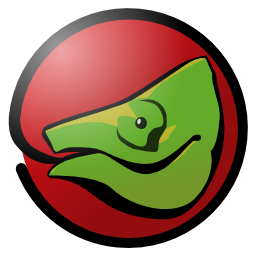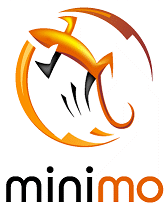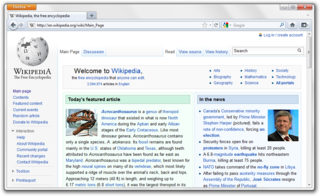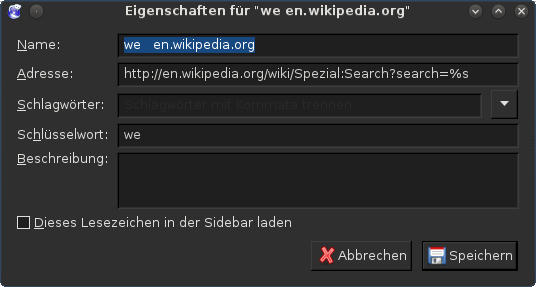- Smart bookmarks usage: Entering a keyword and search a term separated by a blank space into the address bar.
- Smart bookmark creation in Iceweasel
Related Research Articles

Galeon is a discontinued Gecko-based web browser that was created by Marco Pesenti Gritti with the goal of delivering a consistent browsing experience to GNOME desktop environment. It gained some popularity in the early 2000s due to its speed, flexibility in configuration and features.

K-Meleon is a free and open-source, lightweight web browser for Microsoft Windows. It uses the native Windows API to create its user interface. Early versions of K-Meleon rendered web pages with Gecko, Mozilla's browser layout engine, which Mozilla's browser Firefox and its email client Thunderbird also use. K-Meleon became a popular Windows browser and was available as an optional default browser in Europe via BrowserChoice.eu. K-Meleon continued to use Gecko for several years after Mozilla deprecated embedding it. Current versions of K-Meleon use the Goanna layout engine, a fork of Gecko created for the browser Pale Moon.

A bookmarklet is a bookmark stored in a web browser that contains JavaScript commands that add new features to the browser. They are stored as the URL of a bookmark in a web browser or as a hyperlink on a web page. Bookmarklets are usually small snippets of JavaScript executed when user clicks on them. When clicked, bookmarklets can perform a wide variety of operations, such as running a search query from selected text or extracting data from a table.

GNOME Web, called Epiphany until 2012 and still known by that code name, is a free and open-source web browser based on the GTK port of Apple's WebKit rendering engine, called WebKitGTK. It is developed by the GNOME project for Unix-like systems. It is the default and official web browser of GNOME, and part of the GNOME Core Applications.

Avant Browser is a discontinued freeware web browser from a Chinese programmer named Anderson Che with the browser engines Trident, Gecko, and Webkit the user can switch between. It runs on Windows 2000 and above, including Windows 8, Windows 8.1 and Windows 10. Internet Explorer versions 6 through 11 are supported.
A favicon, also known as a shortcut icon, website icon, tab icon, URL icon, or bookmark icon, is a file containing one or more small icons associated with a particular website or web page. A web designer can create such an icon and upload it to a website by several means, and graphical web browsers will then make use of it. Browsers that provide favicon support typically display a page's favicon in the browser's address bar and next to the page's name in a list of bookmarks. Browsers that support a tabbed document interface typically show a page's favicon next to the page's title on the tab, and site-specific browsers use the favicon as a desktop icon.
Google Toolbar was a web browser toolbar for Internet Explorer, developed by Google. It was first released in 2000 for Internet Explorer 5. Google Toolbar was also distributed as a Mozilla plug-in for Firefox from September 2005 to June 2011. On December 12, 2021, the software was no longer available for download, and the website now redirects to a support page.
Furl was a free social bookmarking website that allowed members to store searchable copies of webpages and share them with others. Every member received 5 gigabytes of storage space. The site was founded by Mike Giles in 2003 and purchased by LookSmart in September 2004. Diigo bought it from LookSmart in exchange for equity.

In a web browser, the address bar is the element that shows the current URL. The user can type a URL into it to navigate to a chosen website. In most modern browsers, non-URLs are automatically sent to a search engine. In a file browser, it serves the same purpose of navigation, but through the file-system hierarchy.

Netscape Browser is the eighth major release of the Netscape series of web browsers, now all discontinued. It was published by AOL, but developed by Mercurial Communications, and originally released for Windows on May 19, 2005.

Minimo was a project to create a version of the Mozilla web browser for small devices like personal digital assistants and mobile phones.
Anti-phishing software consists of computer programs that attempt to identify phishing content contained in websites, e-mail, or other forms used to accessing data and block the content, usually with a warning to the user. It is often integrated with web browsers and email clients as a toolbar that displays the real domain name for the website the viewer is visiting, in an attempt to prevent fraudulent websites from masquerading as other legitimate websites.
Mozilla Firefox has features that allow it to be distinguished from other web browsers, such as Chrome and Internet Explorer.

The Mozilla Application Suite is a discontinued cross-platform integrated Internet suite. Its development was initiated by Netscape Communications Corporation, before their acquisition by AOL. It was based on the source code of Netscape Communicator. The development was spearheaded by the Mozilla Organization from 1998 to 2003, and by the Mozilla Foundation from 2003 to 2006.
In the context of the World Wide Web, a bookmark is a Uniform Resource Identifier (URI) that is stored for later retrieval in any of various storage formats. All modern web browsers include bookmark features. Bookmarks are called favorites or Internet shortcuts in Internet Explorer and Microsoft Edge, and by virtue of that browser's large market share, these terms have been synonymous with bookmark since the First Browser War. Bookmarks are normally accessed through a menu in the user's web browser, and folders are commonly used for organization. In addition to bookmarking methods within most browsers, many external applications offer bookmarks management.
This article details features of the Opera web browser.

Mozilla Firefox 4 is a version of the Firefox web browser, released on March 22, 2011. The first beta was made available on July 6, 2010; Release Candidate 2 was released on March 18, 2011. It was codenamed Tumucumaque, and was Firefox's last large release cycle. The Mozilla team planned smaller and quicker releases following other browser vendors. The primary goals for this version included improvements in performance, standards support, and user interface.
Content Security Policy (CSP) is a computer security standard introduced to prevent cross-site scripting (XSS), clickjacking and other code injection attacks resulting from execution of malicious content in the trusted web page context. It is a Candidate Recommendation of the W3C working group on Web Application Security, widely supported by modern web browsers. CSP provides a standard method for website owners to declare approved origins of content that browsers should be allowed to load on that website—covered types are JavaScript, CSS, HTML frames, web workers, fonts, images, embeddable objects such as Java applets, ActiveX, audio and video files, and other HTML5 features.
Firefox was created by Dave Hyatt and Blake Ross as an experimental branch of the Mozilla browser, first released as Firefox 1.0 on November 9, 2004. Starting with version 5.0, a rapid release cycle was put into effect, resulting in a new major version release every six weeks. This was gradually accelerated further in late 2019, so that new major releases occur on four-week cycles starting in 2020.
References
- ↑ "How to Set Keyword Bookmarks in Google Chrome". 22 February 2010.
- ↑ "In Firefox, what are smart keywords and how do I use them?".
- ↑ "Accelerators". 5 November 2020.
- ↑ Shaw, David Andrew (2004-03-22), "OmniWeb 3.0/3.1", Rhapsody Resource Page, retrieved 2012-03-22[ self-published source ]
- ↑ "Smart Bookmarks", The GNOME Project, retrieved 2011-12-14

